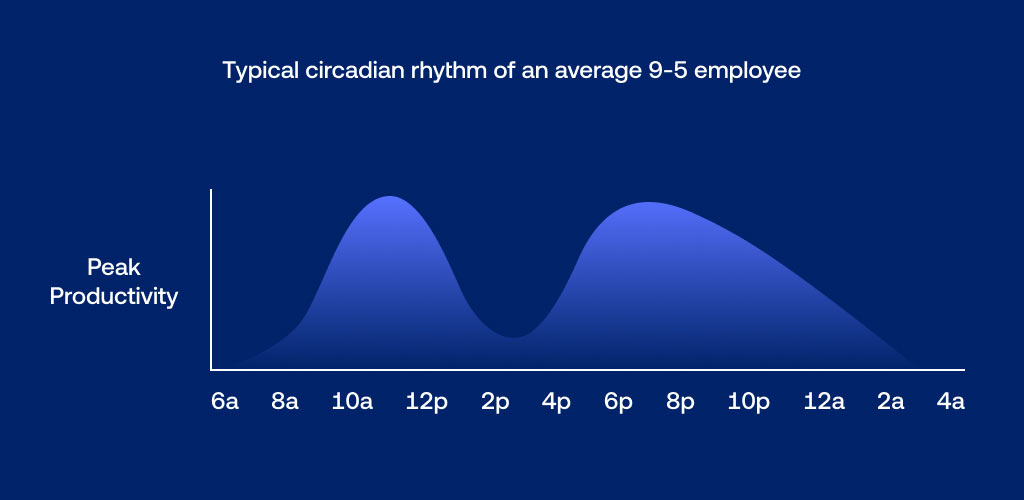One of the most significant implications of a flexible workplace is when work happens.
Pre-COVID, dedicating eight continuous hours to work was standard — even for remote employees. It was either explicitly expressed or culturally understood that employees were available for calls, meetings, and collaborations between, say, 9-5. Want to talk to Sam in Sales? Schedule an event on his calendar between regular working hours.
With some exceptions, we all worked hard to put our personal lives on pause during these predetermined hours.
The great work-from-home experiment has blurred these lines. We’ve all had to get creative in managing our lives, jobs, and kids’ virtual classes within the same chunk of time.
It’s no longer about separating work from home. It’s about harmonizing the two. This won’t change even when offices come back online.
“Our homes are now part of our workplaces.” — Devorah Rosner, Sr. Manager of Global Workplace Operations at Twilio.
And while most leaders assume flexibility means where work happens, the most agile workplaces will understand it also means when it happens.
Expecting employees to be at work and highly productive for eight straight hours isn’t just unrealistic.
It contradicts science.
The science against the 9-5 workday
Our circadian rhythm dictates when we’re productive — and it isn’t for eight continuous hours.
The human body generally has two productivity peaks in the day, shown below.

While factors like diet, exercise, and sleep patterns impact this, typically, the first peak occurs a few hours after we wake up.
For the average 9-5 employee, that’s about the mid-late morning. Right after lunch, the peak levels of alertness and energy decline, hitting a low around 3 p.m. (this is a consequence of our natural circadian rhythm, not because of what we ate for lunch).
After this dip, alertness increases until it hits a second peak around 6 p.m., which is followed by a slow decline (leading to when we go to sleep).
In other words, the average employee is rarely at peak performance while at the office. A 2020 study by Gartner reinforces this — only 36% of employees were high performers at organizations with a standard 40-hour workweek.
The impact of the pandemic
Working from home made clear that conventional hours aren’t required to be productive. Late nights, early mornings, and long breaks in the middle of the day don’t hinder our output.
In fact, for many, they enhance it.
But there’s no denying the value and comfort of accessibility. Working in the same office, or at the same time, as colleagues makes it easier to have impromptu brainstorms in a common area and accidental aha moments on Zoom.
But access in excess is harmful to the flexible workplace, and unless you set clear standards, many employees will resort to what’s familiar to them (a conventional workday). That will kick off a domino effect across your org, because humans conform to social norms for acceptance. We may not want to work all day long. But if our teammates are behind a screen all day, we will be, too.
So how do you support your employees’ needs for both flexible scheduling and access to colleagues?
Create core collaboration hours
As part of Dropbox’s shift to a virtual-first company, they’re ditching regular working hours and adopting core collaboration hours.
Between the hours of 9 a.m. and 1 p.m., employees should be online and accessible to their colleagues. Outside of those hours, employees can design their schedules however they see fit.
This makes sense in the flexible workplace. Many of the tasks we do at work can be performed on our own. Some of our best work is done when we’re uninterrupted for hours at a time.
To produce at your peak level, you need to work for extended periods with full concentration on a single task free from distraction.
Cal Newport, Author of Deep Work
And while it may seem that setting required hours of work is limiting, the opposite is true. By explicitly stating their expectations, Dropbox has freed their employees from the constraints of ambiguity.
If Susie wants to walk her dog at 2 p.m. today, she doesn’t have to fear being ostracized by her colleagues who chose to spend 2 p.m. behind a screen. There is no expectation of attendance beyond these core collaboration hours.
To put it simply, the successful agile workplace team will learn how to measure its employees by their output, rather than an agreed-upon set of hours.
